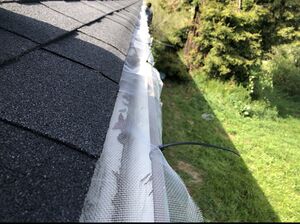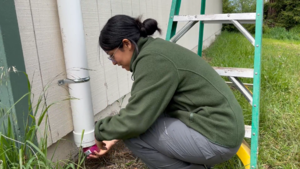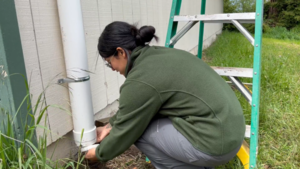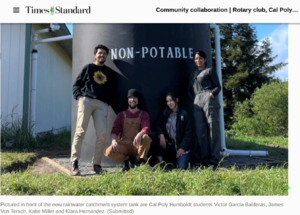
This page details a 3000 gallon rainwater catchment system[1] designed and installed for Arcata Elementary School in Northern California in Spring 2022. The main objective of this project is to provide Arcata Elementary enough water to maintain their garden and nearby orchard. Another major objective of this project is to educate students about water usage and sustainability.
Background[edit | edit source]
Arcata Elementary School is located In the town of Arcata on the coast of Northern California. Students of this elementary school range in age from 5 to 11 years old. They, alongside their teachers, run and maintain a small garden and orchard located on their campus. This garden supports a variety of ornamental plants with edible fruits growing in the orchard. Staff and faculty hope to have a rainwater harvesting system installed to meet all water needs for the garden and orchard. It is unclear at this time how much city water is used for these at this time. This means that our system will be designed to catch the maximum amount of rainwater possible. Arcata receives roughly 46in (116.84cm) of rainwater annually, which makes Arcata a particularly desirable location for rainwater harvesting. In addition to meeting the garden and orchard's water needs, staff and faculty hope to educate students, parents, community members, and others about water consumption and about how rainwater harvesting works in general.
Problem statement[edit | edit source]
The students of Arcata Elementary are looking to develop a fully sustainable and self-sufficient water source for their food garden.
Criteria[edit | edit source]
This section outlines the most important criteria for the Arcata Elementary rainwater catchment system. Adaptability, safety, educational value, maintainability, aesthetics, and cost have been agreed upon as the criteria to focus on. The weight numbers indicate the level of importance our team is placing on each criteria. 10 is defined as the highest weight while 1 indicates the lowest weight. For example, safety and adaptability are the most important criteria while cost is the ranked lowest.
| Criteria | Description | Weight (1-10) |
|---|---|---|
| Adaptability | Our client would like the option to build onto the system that we install. Our system must be sized adequately and ready for additions later on. | 10 |
| Safety | Children ages 5-12 will be interacting with the system. We will also be considering seismic activity and structural security. | 10 |
| Educational Value | Educating children and the community about how this system works is a vital component. Ease of use is also important for educating students. | 9 |
| Maintainability | Many people will be involved in various aspects of maintaining this system. Low maintenance is important for this project. We will also be attaining easy-to-replace hardware for any future maintenance. | 7 |
| Aesthetics | Aesthetics are important since the system will be in view. This will also draw students to the system, ensuring it is not too intimidating. | 5 |
| Cost | Our budget is $4,800. We will ensure our purchasing choices are cost-effective. | 3 |
Literature Review[edit | edit source]
This literature review is intended to illuminate as many aspects of the project as possible. Background information on the client, building codes, similar projects, the system itself, and on the designing of accompanying educational material is included.
Client[edit | edit source]
Arcata Elementary School is a public school located in rural northern California, approximately three miles from the coast. This school is a part of the Arcata School District and is the only elementary school that offers transitional kindergarten through fifth-grade education.[2] Approximately 550 students attend this school which is about average for the elementary schools in the area. 2021 demographic reports indicate that 57% of the student population is white, 18.8% Hispanic/Latinx, with totally minority enrollment at 43%.[3] According to the same demographic survey, 68% of student families identify as economically disadvantaged. In 2021, more kindergarteners were enrolled than in any other grade. Reading and math proficiency are both average compared to U.S standards.
Building Codes[edit | edit source]
Section 1601.3 of California's building code states that a permit must be obtained to construct or install a nonpotable rainwater catchment system. However, according to the same section, "a permit is not required for exterior rainwater catchment systems used for outdoor non-spray irrigation with a maximum storage of 5,000 gallons." This section also states to be exempt from requiring a permit the tank must be placed directly on a slope. The grade of the slope is not specified. The last criteria for building a catchment system without a permit dictates that the storage container must have a 2 to 1 ratio of height to diameter[4].
Similar Projects[edit | edit source]
Many projects similar to this one have been done before. One of the more notable similar projects was done at Zane Middle School in Eureka, California, just over nine miles south of the Arcata Elementary project. This project highlights the importance of understanding and adapting to client needs. In "To Catch the Rain" by Lonny Grafman, the challenges and solutions uncovered in the project are outlined. The catchment system was built in a location where children ages 11 to 13 have access. This access meant that students might have the ability to climb the system, onto the roof.[5] This was a huge safety concern for Zane Middle school. Faculty and staff were worried that students would use the conveyance component to lift themselves to the roof. To solve this problem, a breakpoint was chosen by the designers. A zip-tie was used to hold the conveyance component to the catchment surface and the pipe between the storage container and the catchment surface was attached with a flex fitting.[5] These two design choices dictated where a break would occur and ensured that repair materials were cheap and easily accessible. This creativity in the design process allowed the project to be successful overall. Another relevant example of a similar project is the catchment system installed at a daycare facility in Parras de la Fuente, Mexico. This system was designed to harvest enough water to provide for a small garden and to educate the users. Labels aimed at inspiring and teaching users and community members about water collection and conservation.[5] The importance of including educational material alongside systems like these is highlighted in the daycare project. These two projects are similar in water needs, client needs, and educational needs as the Arcata Elementary School project.
Components[edit | edit source]
General components of a rainwater catchment system require a collection surface area, a water storage, and a pipe system that connects the water to the storage (this is also known as the conveyance system).
Collection Surface Area (Roof)[edit | edit source]
The collection surface area usually is a roof. The roof material affects the water quality, so one must consider what the water will be used for. It is ok to use collected rainwater for growing plants, but if the water is meant to be potable or used for certain edible plants, it is necessary to purify the water first.[5] For our project, we must verify the roof material before we can assess if purification is necessary. This water will supply an edible school garden. To calculate the collection potential of a catchment system, use the following equation: Roof Area (A) X Annual Rainfall (R) X 0.623 X efficiency factor (0.9) (University of Arizona).[6]
Conveyance System[edit | edit source]
The conveyance system is the system of tubes and pipes that connects the water from the collection surface to the storage. Guttering the roof directs the water into the collection system, but this can be inaccessible and expensive (Pacey and Cullis 105). In order to help reduce the cost of materials to build gutters, some people have sourced bamboo, wooden boards, and galvinized metal to build gutters. There are two general kinds of systems for the system: the dry and the wet systems. The dry system rests above ground and is typically only wet when it rains. The wet system is typically at ground level and is vulnerable to freezing because water is always in the low sections of the pipe. In order to prevent improper water flow, it is important to use the correct pipe sizes (University of Arizona).[6]
First Flush[edit | edit source]
A first flush is when the initial rainfall from the collection area is separated from going into the water storage. After a dry period, the collection surface area is likely to have accumulated contaminants and debris such as dust, leaves and bird droppings. The first flush can consist of allowing the first several minutes of rainfall to clear out the debris from the roof or integrating first-flush mechanisms into the catchment system (Gould and Petersen 154).[7] A mechanism we hope to implement is the floating ball method. The floating ball method is a diversion device that fills up with the contaminated water before allowing the clean water to flow into the storage container. In the figure below, we can see that the ball acts as a plug to stop more water from diverting into the first flush compartment because the container has reached its capacity. Now the clean water flows into the storage.
Child Education on Water Conservation[edit | edit source]
Educating children on the importance of water conservation is needed for the future of society and the planet. Therefore, it is crucial the children to be taught in a manner that will maximize understanding. The goal of ecology education is to foster ecological literacy, defined as an understanding of the scientific process at work in ones local environment; a familiarity with the ecological processes at work in one's local environment; and sufficient familiarity with ecological principles to be able to understand the basic ecology of environmental problems in other regions.[8] From the broad-scale movement for reform within the education community at large we see consistent trends for: emphasizing depth over breadth, empowering teachers, promoting interdisciplinary study, providing opportunities for hands-on learning, and serving the full spectrum of learners.[8] Choosing an exploration model ("Watershed Explorer"), based on children's experiencing nature firsthand, for its ability to capture the imagination and for its focus on observation, which enables children to seek consciously for information that will extend their ideas.[9] Installing a rain harvesting system under one of the downspouts from your roof will teach kids firsthand that the notion of an endless supply of water is really an illusion. A rain harvesting system will be a stark reminder to your kids that nature can be capricious.[10]
Designing interpretive materials[edit | edit source]
Creating educational and interpretive materials to accompany sustainable, hands-on infrastructure such as rainwater catchment systems allows for a broad audience to learn about such systems. Ensuring that any accompanying material is engaging, versatile, and accessible is essential for the success of the material in reaching children. Dennis Littky highlights the importance of creating meaningful educational material in "The Big Picture: Education is Everyone's Business." He writes that students often use words like "boring" to describe education because they are not given material that interests them.[11] He goes on to write that real learning happens when students are given the opportunity to engage with material in ways that are personally relevant or interesting to them.[11] Versatility and accessibility both play important roles in the designing of educational material also. Creating material that minimizes the effort required from learners increases their levels of motivation and concentration.[12] Decreasing the amount of unnecessary stimuli also makes the material more accessible. The design of educational material, like the catchment system itself, takes into account a wide array of client needs and goals.
Water Pressure[edit | edit source]
Water pressure is critical for a functioning rainwater catchment system. Therefore, understanding water pressure is just as important. Pressure at any point in a liquid is determined by the depth at which the pressure is measured. At any specific depth, pressure is caused by the weight of liquid above that point.[13] In other words, water pressure is created by the weight of water trying to flow to a lower height.[14] In a fluid at rest, the resultant force exerted on a particle is zero. The tension of the surface element of the fluid is normal to that element and, at a given point, identical in all directions. This tension is known as pressure.[15] The first three terms on each side of the equation are the pressure, elevation, and velocity heads, respectively. The pressure head provides a means for doing work, and the elevation head and velocity head are in turn the potential energy and kinetic energy on a per-unit-weight basis.[16] Water pressure can be also created by pumps where water is needed to be pushed to places that are higher up.[14]
Solar Pump[edit | edit source]
In a situation where gravity cannot be effectively used to create enough pressure to move water from storage to end use (such as when building on flat land or having storage that is too heavy to elevate) a pump may become necessary. While buying and powering a pump can be costly, a solar power pump can be a cost effective option. Conventional AC centrifugal pumps consume high amounts of power and are designed to pump as much water per minute as possible. High pressures (which you would have if your tank is too heavy to be raised) lead to even lower efficiency on AC pumps. DC voltages on a solar array, on the other hand, are designed to be close to the draw of the pump, increasing efficiency. This can come with a decreased rate of pumping with a decrease in power (such as on a cloudy day), however this can still be a considerable amount of water.[17]
Contaminants[edit | edit source]
While rainwater is relatively free of contaminates, besides those that are picked up in the atmosphere, the quality of rainwater can fall quickly during catchment, storage, and end use. Debris that can pollute the water and introduce bacteria and pathogens include dirt, leaves, fecal matter from animals, insects and contaminated trash.[18] Poor hygienic practices in storing and using water can also lead to contamination. Pathogens commonly found in contaminated rainwater include E. Coli, Cryptosporidium, Giardia, Campylobacter, Vibrio, Salmonella, Shigella and Pseudomonas. These risks can be minimized with a well designed and maintained system and good hygiene. Risk of contamination is increased during the first rain and decreases after frequent rainfall. (WHO)
Roofing material is also a potential source of contamination. This includes arsenic, cadmium, chromium, copper, lead, nickel, zinc, phthalates, biocides, nonylphenols, and thiocyanate.[19] Types of common roofing material include Asphalt, Tile, Concrete, Corrugated metal, Standing seam metal, and Thatch. About 75% of new construction and re-roofing in steep-slope buildings uses asphalt shingles, their most common use being in North America. This is due to their low cost and ease of maintenance and installation. Runoff from asphalt shingled roofs have been shown to contain low concentrations of metals. A single shingle is made up of a base of either fiberglass mat or asphalt that is impregnated with organic or inorganic felt or felt stock. About 97% of a shingle is covered with crushed rock granules.[20] Copper can be contained in these granules in algae resistant asphalt roofs, which over time slowly release between 560 and 640 ug/L of copper oxide to prevent discoloration of the roof.[19]
Since rainfall is slightly acidic, it can potentially dissolve material from the catchment area and storage tank. While the concentration of chemicals is mostly insignificant, there have been cases of concentrations of lead and zinc being reported. Care should be taken to understand the differences in water quality based off different types of roofing materials. Storage containers should also be chosen that present a minimal risk of chemical concentrations.[21]
Prototyping[edit | edit source]
-
Cardboard and Paper Prototype Built To Scale
Construction[edit | edit source]
-
Team purchasing pvc pipe
-
Klara installing gutter screen
-
Klara and James on the roof ready to install gutter screen
-
Gutter screen
-
Rotary Club Volunteers digging 6 inches for the storage tank foundation
-
Victor drilling holes to be able to ziptie the gutter screen.
-
Victor and Rotary Club volunteer dumping in pea gravel with a wheelbarrow
-
Katie and Rotary Club volunteers digging a six inch deep foundation to support the storage tank.
-
James using the compactor rental
-
Klara screwing on the lid of the storage tank and waving at the curious kids at the tops of the jungle gym
-
Tractor Supply Co dropping off the storage tank!
-
Victor and James calculating the appropriate size of the first flush before installation
-
Klara and Katie taking measurements for pvc pipe installation
-
spray painting "Non-Potable" on the storage tank
-
Pvc pipe cuts
Video instructions[edit | edit source]
Proposed Timeline[edit | edit source]
Proposed timeline for the process of building the Arcata Elementary School Rainwater Catchment System.
| Week | Description | Status |
|---|---|---|
| 7 (2/28 - 3/6) | Design alternative solutions | Complete |
| 8 (3/7 - 3/13) | Consult prototypes with Dave | Complete |
| 9 (3/14 - 3/20) | Create prototype, consult with Arcata Elementary | Complete |
| 10 (3/21 - 3/27) | Gather system materials | Complete |
| 11 (3/28 - 4/3) | Build system | Complete |
| 12 (4/4 - 4/10) | Test system, add educational features | Complete |
Costs[edit | edit source]
Materials needed for a successful rainwater catchment system appropriate for this location.| Item | Qty | Price/ Unit | Total |
|---|---|---|---|
| Storage Tank (3,000 gal) & Delivery | 1 | $3,650.48 | $3,650.48 |
| Ball (for first flush) | 1 | $4.65 | $4.65 |
| Interp Panel (awaiting quote) | 1 | TBA | TBA |
| Foundation (Pea Gravel) | 1 | $0 | $0 |
| Compactor Rental | 1 | $49.16 | $49.16 |
| Gutter Screen | 1 | $0 | $0 |
| Mosquito Screen | 1 | $0 | $0 |
| Zipties | 2 | $8.15 | $16.30 |
| Flag Markers | 1 | $12.34 | $12.34 |
| Screws | 55 | $0.55 | $38.92 |
| Twine | 1 | $3.99 | $3.99 |
| PVC Glue | 1 | $6.30 | $6.30 |
| Skirt Wood (2 10ft 4x6 + 2 12ft 4x6) | 4 | $60 | $140 |
| 3 inch Male and Female Parts | 2 | $7.19 | $14.39 |
| Small Screws | 25 | $0.25 | $6.10 |
| Spray Paint | 1 | $5.59 | $5.59 |
| Stencil Set | 1 | $13.59 | $13.59 |
| Leaf Eater | 1 | $65.05 | $65.05 |
| PVC Pipe (3"x10") | 2 | $34.99 | $80.63 |
| Cap Screw | 1 | $8.98 | $8.98 |
| Elbows | 4 | $7.60 | $30.41 |
| Brackets 4" | 3 | $2.97 | $8.91 |
| Brackets 3" | 1 | $2.33 | $2.33 |
| T Fitting | 1 | $7.45 | $7.45 |
| Couple Flex 4"x3" | 1 | $6.73 | $6.73 |
| Plug Cleanout | 1 | $4.29 | $4.29 |
| Multi Saw Set | 1 | $14.47 | $14.47 |
| Clamp | 1 | $0.84 | $0.84 |
| Corrugated Coupling 3x3 | 1 | $8.84 | $8.84 |
| Drill Bit | 1 | $3.21 | $3.21 |
| Saw Hole | 1 | $13.99 | $13.99 |
| Male Adapter | 1 | $1.89 | $1.89 |
| Ball Valve | 1 | $12.50 | $12.50 |
| Wire | 1 | $0.86 | $0.86 |
| Seal Tape | 1 | $0.82 | $0.82 |
| Total | $4,249.42 |
Operation[edit | edit source]
Rainwater falls on the maintenance building roof and flows through the gutter into the first flush for cleansing out debris and most polluted water from the first rains then stored in the storage tank. The first flush is 4 inches wide and contains a plastic ball inside to plug the opening to allow the dirtiest portions of the rain to flush out through the hole screwed into the bottom. The water will flow through the 4 inch pipes into the storage tank for use in the elementary school gardens.
Maintenance[edit | edit source]
The Rainwater Catchment System ought to be inspected monthly for large debris over the gutter screens and the funnel screen. The maintenance person at the elementary school will need to remove the cap at the bottom of the first flush to empty out any large debris then can place the cap back on.
Cleaning Schedule[edit | edit source]
- Monthly
- Gutter screen cleaning
- Funnel screen cleaning
- Every rainfall
- Empty first flush
Instructions[edit | edit source]
This is a plan to maintain your project. The step by step how to template {{Steps}} is most likely the best way to display a process, which will look like this:
Conclusion[edit | edit source]
Testing results[edit | edit source]
We experienced heavy rainfall the night after completing the system. Our team observed the system during and after this rain to check that it works properly. We immediately noticed that we had forgotten to cement the fitting with the screwcap to the bottom of the first flush. This fitting popped off and we lost all of the water from that rain event. This ended up working in our favor, however, because the small evacuation hole we drilled at the bottom of the first flush was too large. Water was evacuating much too quickly. To fix this, we sawed a very small section of the bottom of the first flush off. This allowed us to cover our initial evacuation hole with the fitting that we had forgotten to cement on. We then drilled a significantly smaller evacuation hole at the bottom of the newly cut first flush.
Discussion[edit | edit source]
Our team learned a great deal from this project. If this page is being used as a reference for future projects, we would like to make note of some areas that can be improved upon. The most notable being that the tank is slightly too large for the location. We did not account for the height we would lose due to the leaf-eater and conveyance piping. Ensure that there is enough clearance so that the full capacity of the tank can be utilized. We also encountered delays in creating educational signs for this project. Communications should start early. Overall, this system should supply Arcata Elementary School with enough water to provide for their garden and small orchard. Humboldt County (in California, USA) is a generally rainy location and should fill the tank easily during the rainy season. Even in draught years, Humboldt County should experience enough rain to provide for Arcata Elementary.
Lessons learned[edit | edit source]
We have definitely experienced some lessons to learn. First of all, we would have like to speed up the process of communication and getting all parties aligned to move the project forward. A more organized effort would have saved time. Another thing that took a lot of time was installing our DIY gutter screen. The screen was donated by CCAT so we did save money on that but we had the budget in this case for this project so we could have purchased a much sturdier, longer lasting gutter screen. Another lesson to learn is having more time put aside for this project, we could have done more detailed further planning for this project and take on each week easier. Also, triple checking math would have saved some time as well. We came across many hurdles as we planned this project. Communicating between such a large number of involved people pushed us down bureaucratic roads we were not expecting. Our team handled each hurdle as they came.
Troubleshooting[edit | edit source]
This is only how to troubleshoot basic operation. For issues regarding the foundation, please contact trusted persons for assessment and guidance.
| Problem | Suggestion |
|---|---|
| Low pressure | A pump could be attached to this system to gain adequate pressure. Solar pumps are recommended. See our literature cited section for more information on solar pumps. |
| Low water collection from rains. | Make sure gutters and screens are clean. Make sure all pipes are free of cracks. |
| Water seems dirty or contaminated. | Make sure first flush is emptied and ball is still attached. |
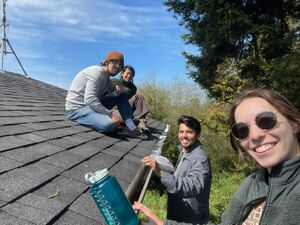
Team[edit | edit source]
Spring 2022
- Klara Hernandez is a senior majoring in Environmental Studies and emphasizing in Appropriate Technology. Klara is a former Co-Director of CCAT from Fall 2020 - Fall 2021.
- Katie Miller is majoring in Environmental Science and Management with a concentration in energy in climate at Cal Poly Humboldt.
- Victor Garcia Balderas is majoring in Botany with a minor in Environmental Ethics. Victor has a passion for science education.
- James Von Tersch is a senior majoring in Environmental Studies with an emphasis in Appropriate Technology.
Press[edit | edit source]
- https://www.times-standard.com/2022/05/29/community-collaboration-3/
- https://www.facebook.com/arcataschooldistrict/posts/53122-update-check-out-the-great-times-standard-article-on-this-fantastic-projec/3160795247542459/
References[edit | edit source]
- ↑ https://www.watercache.com/education/rainwater-harvesting-101
- ↑ Arcata Elementary. (2022). Arcata Elementary Classrooms. Arcata Elementary. Retrieved February 12, 2022, from https://www.arcataelementaryschool.org/
- ↑ US News. (2019). Arcata Elementary in California - U.S. news education. Best Elementary Schools US News Ranking. Retrieved February 14, 2022, from https://www.usnews.com/education/k12/california/arcata-elementary-239542
- ↑ California Plumbing Code. (n.d.). Chapter 16: Nonpotable Rainwater Catchment Systems. UpCodes. Retrieved February 12, 2022, from https://up.codes/viewer/california/ca-plumbing-code-2016/chapter/16/nonpotable-rainwater-catchment-systems#16
- ↑ 5.0 5.1 5.2 5.3 Grafman, L. (2018). Full Systems and Stories. In To Catch the Rain (pp. 93–98). essay, Appropedia Foundation.
- ↑ 6.0 6.1 University of Arizona. (2012). Basic Components of a Rainwater Storage System. Retrieved February 12, 2022 from https://wrrc.arizona.edu/
- ↑ Gould, J. and Nissen-Peterson, E. Rainwater Catchment Systems for Domestic Supply: Design, Construction and Implementation. Intermediate Technology Publications, London, 335, 1999.
- ↑ 8.0 8.1 Hale, Monica. "Ecology in Education." New York: Cambridge University Press, 1993.
- ↑ Barlow, Zenobia and Michael K. Stone. "Ecological Literacy: Educating Our Children for a Sustainable World." California: Sierra Club Books, 2005.
- ↑ Elliot, Sara. "Five Ways to Teach Your Kids About Water Conservation." 4 April 2012. HowStuffWorks.com
- ↑ 11.0 11.1 Littky, D., & Grabelle, S. (2004). Real Work in the Real World. In The Big Picture Education is everyone's business (pp. 111–115). essay, Association for Supervision and Curriculum Development.
- ↑ Bitgood, S. (2000). The role of attention in designing effective interpretive labels. Journal of Interpretation Research, 5(2), 31–45. https://doi.org/10.1177/109258720000500205
- ↑ Lynch, Mary Jean, and John Zenchak. "Water Pressure in Depth." Science and Children 48, no.7 (2011): 54–57. http://www.jstor.org/stable/43175489.
- ↑ 14.0 14.1 Bitesize. "What is Water Pressure?" BBC. 2022. https://www.bbc.co.uk/bitesize/topics/z4brd2p/articles/zv6kw6f
- ↑ Lencastre, Armando. "Handbook of Hydraulic Engineering." Portugal: English Language Edition Ellis Horwood Limited, 1987.
- ↑ Prasuhn, Alan L. "Fundamentals of Hydraulic Engineering." New York: Oxford University Press, 1992.
- ↑ Kinkaid, Christopher, "Solar PV Water Pumping" Createspace Independent Publishing (2014)
- ↑ Hamilton, K., Reyneke, B., Waso, M. et al. "A global review of the microbiological quality and potential health risks associated with roof-harvested rainwater tanks." npj Clean Water 2, 7 (2019).
- ↑ 19.0 19.1 Winters, Nancy, et. al. "Roofing Materials Assessment: Investigation of Five Metals in Runoff From Roofing Materials" Water Environment Research. 2015 doi: 10.2175/106143015X14362865226437
- ↑ Sackey, Solomon, and Kim, Byung-Soo. "Environmental and Economic Performance of Asphalt Shingle and Clay Tile Roofing Sheets Using Life Cycle Assessment Approach and TOPSIS" 2018. Journal of Construction Engineering and Management.
- ↑ Pathak, Namrata, and Heijnen, Han, "Rainwater Harvesting and Health Aspects- Working on WHO guidance" University of Hawaiʻi (2006)
















